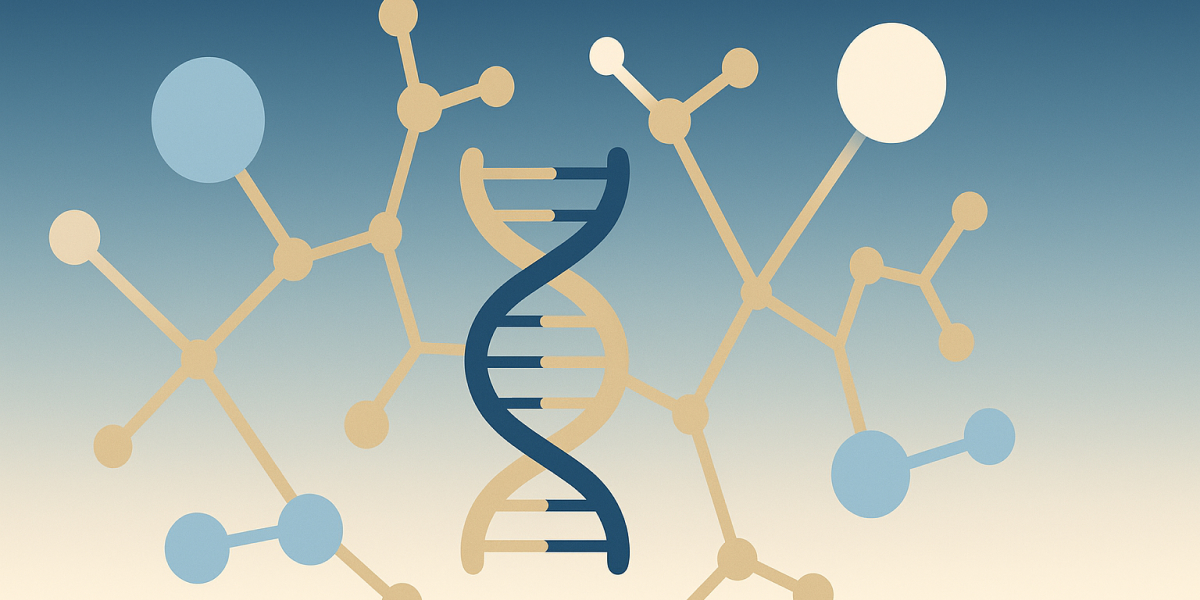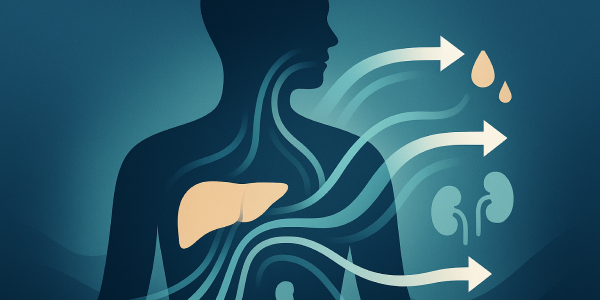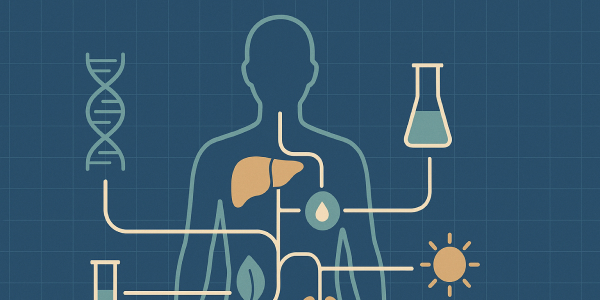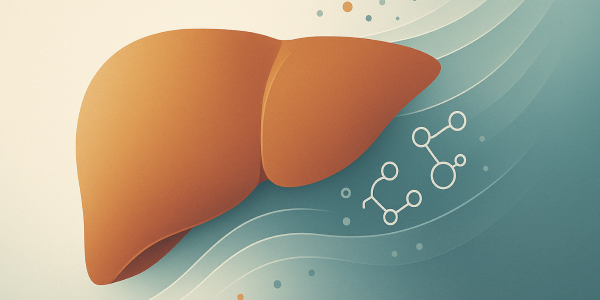The Methylation Gene Network: Beyond Just MTHFR


In the article titled What Is DNA Methylation and Why Does It Matter?, we introduced MTHFR as the "gateway gene" that's captured everyone's attention in the methylation conversation. And it deserves that spotlight. But here's what most people miss, MTHFR is just one player in a complex biochemical network.
Think of methylation like a relay race. MTHFR might be the runner everyone watches, but if the other runners drop the baton, stumble, or run in the wrong direction, the whole team suffers. Your methylation capacity isn't determined by one gene, it's shaped by how multiple genes work together, pass molecules back and forth, and support or strain each other.
Today, we're zooming out to see the bigger picture. The methylation gene network and why understanding these connections changes everything.
Understanding the Two Main MTHFR Variants: C677T & A1298C
Before we go broader into the gene network, it's important to understand that not all MTHFR variants are created equal. In the last article, we discussed MTHFR as the headliner in the methylation pathway show. Let’s go one level deeper. There are two very specific gene variants (both MTHFR) that affect very different aspects of the methylation pathway.
Here's a quick primer on how this works: each gene is made up of thousands or tens of thousands of individual building blocks called base pairs, or SNPs (single nucleotide polymorphisms). We can look at each one individually to find relevance. In the case of MTHFR, researchers have found two particular variants, the C677T and A1298C variants, that have been shown to deeply affect the methylation pathway.
The C677T Variant:This variant directly reduces the enzyme's ability to convert regular folate into activated vitamin B9 (the form your body can actually use called methylfolate). With one copy, enzyme function drops to about 65% of normal. If you have two copies of this variant, it drops to about 30% of normal. The primary impact here is elevated homocysteine and impaired overall methylation capacity. This variant typically shows up on blood work as elevated homocysteine levels.
The A1298C Variant:This variant affects a different part of the enzyme and impacts something called BH4, which is essential for producing your key brain chemicals, dopamine, serotonin, and norepinephrine. With two copies, enzyme function drops to about 60-70% of normal. The primary impact is neurotransmitter imbalances, which show up as mood issues and heightened stress reactivity. Interestingly, homocysteine often appears normal on labs despite significant symptoms.
Compound Heterozygous (One Copy of Each):When you have one copy of C677T and one copy of A1298C, enzyme function drops to about 50-60% of normal, and you get impacts on both pathways, methylation/homocysteine issues and neurotransmitter production problems. This is why some people struggle with both physical symptoms like cardiovascular risk and detox issues alongside mental health symptoms like anxiety and depression. This distinction matters enormously for treatment strategy, which we'll cover in .
Now, let's explore how MTHFR fits into the larger methylation network.
The Three Pillars of Methylation: Core, Disposal, and Consumers
To understand the methylation network, it helps to think of it in three main categories:
- Methylation Core: Genes that activate folate and create the methyl donors your body needs
- Homocysteine Disposal: Genes that convert or break down homocysteine (preventing buildup)
- Methylation Consumers: Genes that use methyl groups for critical functions throughout the body
Let's explore each pillar and the key genes involved.
Methylation Core: Creating the Methyl Donors
These genes are responsible for activating folate, creating SAMe (your universal methyl donor), and keeping the methylation cycle running smoothly.
MTHFR: The Gateway Gene
We've already introduced MTHFR, but here's its role in the core pathway: it converts folate (vitamin B9) from food (or supplements) into 5-MTHF, the active form your body can actually use. Without this conversion, the entire downstream methylation process struggles.
MTR and MTRR: The Methionine Cycle Keepers
After MTHFR converts folate into its active form (5-MTHF), that molecule needs to go somewhere useful. This is where MTR (methionine synthase) enters the picture.
What MTR does: It takes that active folate from MTHFR and uses it, along with vitamin B12, to convert homocysteine into methionine. Methionine is then converted into SAMe (S-adenosylmethionine), your body's primary methyl donor. SAMe is the currency of methylation, it's what actually delivers methyl groups throughout your body.
When MTR is impaired: Homocysteine can build up (cardiovascular risk), and you produce less SAMe (affecting everything from mood to detoxification). B12 becomes even more critical when MTR variants are present.
MTRR (methionine synthase reductase) is MTR's support crew. Think of MTR as a worker that occasionally needs to be "recharged" to keep functioning. MTRR does that recharging using vitamin B2 (riboflavin).
When MTRR is impaired: MTR can't be properly reactivated, creating a bottleneck. The whole methionine-to-SAMe cycle slows down, even if MTR itself is genetically fine.
Key insight: MTHFR gets you active folate, but without functional MTR and MTRR, that folate has nowhere productive to go. This is why some people take methylfolate but don't feel better, downstream genes might need attention.
MAT1A: The SAMe Factory
What MAT1A does: This gene produces the enzyme that converts methionine into SAMe. Think of it as the factory that creates your body's methylation currency. Without adequate SAMe production, the entire methylation system grinds to a halt, it doesn't matter how well your other genes function if you can't make enough SAMe.
When MAT1A is impaired: SAMe levels drop, and methylation capacity across all pathways suffers. This can manifest as mood issues (SAMe is a potent antidepressant), liver dysfunction (SAMe is critical for liver detox), and joint problems (SAMe supports cartilage health).
Clinical insight: People with MAT1A variants often benefit from direct SAMe supplementation (400-800mg daily), which bypasses the genetic bottleneck entirely.
AHCY: The Methylation Brake Release
What AHCY does: After SAMe donates its methyl group, it becomes SAH (S-adenosylhomocysteine). AHCY breaks down SAH back into homocysteine. This might sound backwards, but it's essential, accumulated SAH actually inhibits methylation enzymes. AHCY essentially releases the brake on methylation.
When AHCY is impaired: SAH builds up and creates a negative feedback loop, shutting down methylation even when you have adequate SAMe. It's like having plenty of fuel but a stuck accelerator pedal.
The vicious cycle: High SAH → inhibited methylation → more SAH accumulation → further methylation impairment. Breaking this cycle often requires aggressive B vitamin support and reducing factors that increase SAH (like alcohol and certain medications).
The Supporting Folate Cycle Genes
MTHFD1 and MTHFD1L: These genes convert between different forms of folate within the folate cycle. They're less commonly problematic than MTHFR, but variants can create subtle inefficiencies. Think of them as the "middle management" of the folate pathway, when they're working well, you don't notice them, but dysfunction creates bottlenecks.
SHMT1 and SHMT2: Convert the amino acid serine into glycine while producing one-carbon units for methylation. SHMT1 works in the cytoplasm, SHMT2 in the mitochondria. Variants here can affect both methylation capacity and mitochondrial function. Glycine supplementation (3-5g daily) can sometimes help support these pathways.
DHFR (Dihydrofolate Reductase): Converts synthetic folic acid into usable forms. This is why people with DHFR variants often feel worse taking standard prenatal vitamins or fortified foods containing folic acid, they can't convert it efficiently, and it may even block folate receptors. These individuals do much better with natural folate from food or pre-methylated supplements.
Homocysteine Disposal: Managing the Buildup
Homocysteine is a byproduct of the methylation cycle. When it accumulates, it becomes toxic, damaging blood vessels, creating inflammation, and increasing cardiovascular risk. Your body has two main pathways to clear homocysteine: recycling it back to methionine (via MTR, which we covered above) or breaking it down via a different route.
BHMT: The Backup Pathway
Your body is remarkably clever. If the main folate-dependent pathway (MTHFR → MTR) is struggling, there's an alternative route: BHMT (betaine-homocysteine methyltransferase).
What BHMT does: It converts homocysteine into methionine using betaine (trimethylglycine, or TMG) as the methyl donor instead of relying on folate and B12. This pathway is particularly active in the liver and kidneys.
When BHMT is impaired: Your backup system weakens. If you also have MTHFR or MTR issues, homocysteine has fewer escape routes. This is where homocysteine levels can really climb.
Why this matters: People with BHMT variants often benefit significantly from TMG/betaine supplementation or choline (which converts to betaine). It's like opening a secondary valve when the main pipeline is congested.
Interesting connection: BHMT activity is also influenced by stress and cortisol levels. Chronic stress can downregulate BHMT, making methylation issues worse during high-stress periods, something we'll explore more in Methylation, Stress & Mental Health: The Anxiety Connection.
CBS: The Homocysteine Exit Strategy
While MTHFR, MTR, and BHMT all deal with converting homocysteine into something useful, CBS (cystathionine beta-synthase) takes a different approach: it helps break homocysteine down and send it toward other pathways.
What CBS does: It converts homocysteine into cystathionine using vitamin B6, which then gets converted into cysteine and eventually taurine or glutathione (your master antioxidant). This is sometimes called the "transsulfuration pathway."
When CBS is upregulated (some variants cause increased activity): Homocysteine gets shunted too quickly down this pathway, potentially depleting methionine and SAMe. You might also produce excess sulfur metabolites, which some people are sensitive to. Paradoxically, you might have low homocysteine but still have methylation problems.
When CBS is downregulated (other variants reduce activity): Homocysteine has one less exit route, and you may struggle to produce adequate glutathione for detoxification.
The B6 connection: CBS is vitamin B6-dependent. Many people with CBS variants need to optimize their B6 status, but the form matters. Some do better with P5P (pyridoxal-5-phosphate), the active form of B6.
Methylation Consumers: Using Methyl Groups Throughout the Body
Once SAMe is produced, it gets used for critical functions throughout your body. These "consumer" genes take methyl groups from SAMe and apply them where needed, from breaking down neurotransmitters to metabolizing hormones to producing phospholipids for your brain.
COMT: The Neurotransmitter and Hormone Regulator
COMT (catechol-O-methyltransferase) breaks down catecholamines like dopamine, norepinephrine, and epinephrine, as well as estrogen. It uses SAMe as its methyl donor.
When COMT is slow due to certain variants, catecholamines and estrogen linger longer in your system. This can create anxiety, racing thoughts, and difficulty "shutting off" your mind. People with slow COMT often experience stress intolerance and overstimulation, estrogen dominance symptoms, and heightened sensitivity to stimulants like caffeine or stressful situations.
On the flip side, when COMT is fast (less common variants), catecholamines clear too quickly. This can show up as low motivation or drive, difficulty maintaining focus, and a need for more stimulation to feel engaged.
Here's why this matters for methylation: COMT consumes a lot of SAMe. If methylation is already impaired and you're producing less SAMe, COMT function suffers. Neurotransmitters and hormones don't get cleared properly, creating the "wired but tired" feeling we discuss in Methylation, Stress & Mental Health: The Anxiety Connection.
PEMT: Brain and Membrane Health
What PEMT does: This gene uses SAMe to produce phosphatidylcholine, a critical phospholipid for cell membranes, especially in the brain and liver. It's particularly important for cognitive function and liver fat metabolism.
When PEMT is impaired: Increased risk of fatty liver disease, cognitive decline, and choline deficiency, even with adequate dietary choline intake. Women are particularly affected because estrogen upregulates PEMT, so variants become more apparent after menopause when estrogen drops.
Intervention: Direct phosphatidylcholine or CDP-choline supplementation (300-600mg daily) can bypass PEMT limitations.
Why Single-Gene Testing Misses the Point
Here's where some conventional approaches fall short, most people get their MTHFR tested, or a handful of related genes, see they have a variant or variants, start taking methylfolate, and wonder why they don't feel dramatically better, or worse, why they feel worse.
The answer usually lies in the network:
Scenario 1: You have MTHFR variants and take methylfolate, but you also have MTR or MTRR variants. The active folate piles up with nowhere to go efficiently. You might feel overstimulated, anxious, or experience side effects.
Scenario 2: You have MTHFR and BHMT variants. Your main pathway is sluggish, your backup pathway is sluggish, and homocysteine climbs. You need both methylfolate support AND betaine/TMG to open both routes.
Scenario 3: You have MTHFR variants but upregulated CBS. You're shunting homocysteine down the transsulfuration pathway too quickly, depleting your methyl groups before they can be used for other critical functions. Adding more methylfolate might help, but you also need to support the methionine/SAMe cycle more directly.
Scenario 4: You have multiple variants across MTHFR, MTR, and CBS. Your methylation is compromised from multiple angles. You need a comprehensive strategy that addresses folate, B12, B6, riboflavin, and possibly betaine—not just one supplement.
The Bigger Picture: It's a System, Not a Single Point of Failure
Methylation is a network of biochemical reactions working in concert. When you view it this way, several things become clear:
Compensation patterns: Your body is adaptive. If one pathway is weak, it often upregulates another to compensate, until that pathway becomes overwhelmed too.
Nutrient dependencies multiply: Each gene in this network depends on specific nutrients. MTHFR needs folate, MTR needs B12, MTRR needs B2, BHMT needs choline/betaine, CBS needs B6. A deficiency in any of these creates a weak link.
Lifestyle factors affect the whole network: Stress, toxin exposure, inflammation, gut health, and alcohol consumption impact multiple genes simultaneously. This is why two people with identical genetics can have vastly different experiences.
Testing gives you the blueprint, but symptoms tell the story: Knowing your genetic variants is helpful, but how you feel, your health history, and your lab markers (like homocysteine) provide critical context.
What This Means for You
Understanding the methylation network shifts your perspective from "I have bad genes" to "I understand where my body needs support."
It also explains why cookie-cutter protocols don't work. Methylation support isn't about everyone taking the same supplements, it's about identifying where YOUR pathways need help and providing targeted support.
In the coming weeks, we'll explore what happens when this network malfunctions, starting with one of the most common and misunderstood connections: methylation's profound impact on stress, anxiety, and mental health.











.svg)